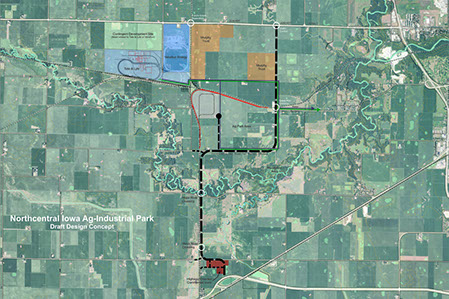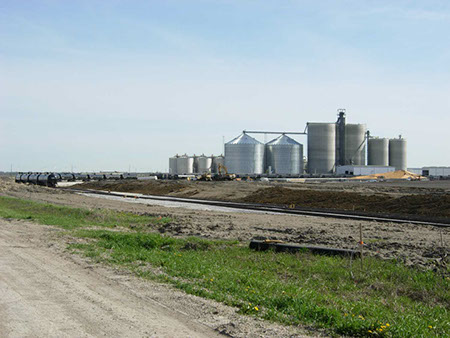PLACE DYNAMICS
This project entailed the market feasibility, site selection, and conceptual planning for an industrial park designed to attract heavy industry. While many places market themselves as an ideal location for heavy agricultural-related industrial uses, few actually have the depth of resources necessary to serve the industry. Fort Dodge is a notable exception.
Our analysis demonstrated sustained demand for a wide range of uses related to agriculture, including food processing, ethanol and bio-deisel production, plant-derived enzymes, food processing, agricultural machinery manufacturing, grain storage, cold storage, and related uses.
In selecting a site, we recommended a highway location at the junction of two rail lines (UP and CN) to provide great flexibility in shipping options. The site is located outside of the city where truck traffic, noise, steam, and odors will not impact the community.
The industrial park was designed with redundant utilities and the capacity to meet any level of demand. Electrical power is supplied from three sources, and the park was designed with the thought of accommodating a co-generation plant. A looped 30-inch main and proposed 1 million gallon elevated storage tank supply water, while twin 16-inch force mains carry wastewater back to the City’s treatment plant.
Sites are laid out in a range of sizes from 20 acres or larger, all of which will have access to a shared rail track connecting to both mainlines. The plan recommended designating the area around a nearby highway interchange for smaller uses related to the park, such as fueling, truck servicing, and other services. It also recommended a zoning overlay to prohibit residential development within a 1,500 foot buffer zone.
Transportation improvements include the internal road network and upgrades to roads between the park site and the Highway 20 interchange. Traffic volume is projects at over 11,000 vehicle trips per day.
Total infrastructure costs for the 1,800-acre industrial park were estimated to approach $45 million upon build-out. This investment was projected to attract $1 billion in private capital resulting in $400 million in assessed value. About 3,500 jobs could be expected to be created.
The plan did identify possible sources of state and federal funding to defray costs, and laid out a staged plan of development. The park is currently anchored by a bio-deisel plant and the first wet corn mill to be constructed in the United States since the 1970’s.
INDUSTRIAL PARK PLAN
WEBSTER COUNTY, IOWA


%20blue.png?crc=251000060)
3090 S. Country Lane | New Berlin | Wisconsin | 53146 Email
(262) 510-2131 | Wisconsin
(720) 440-2131 | Colorado